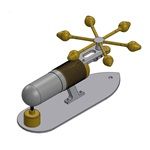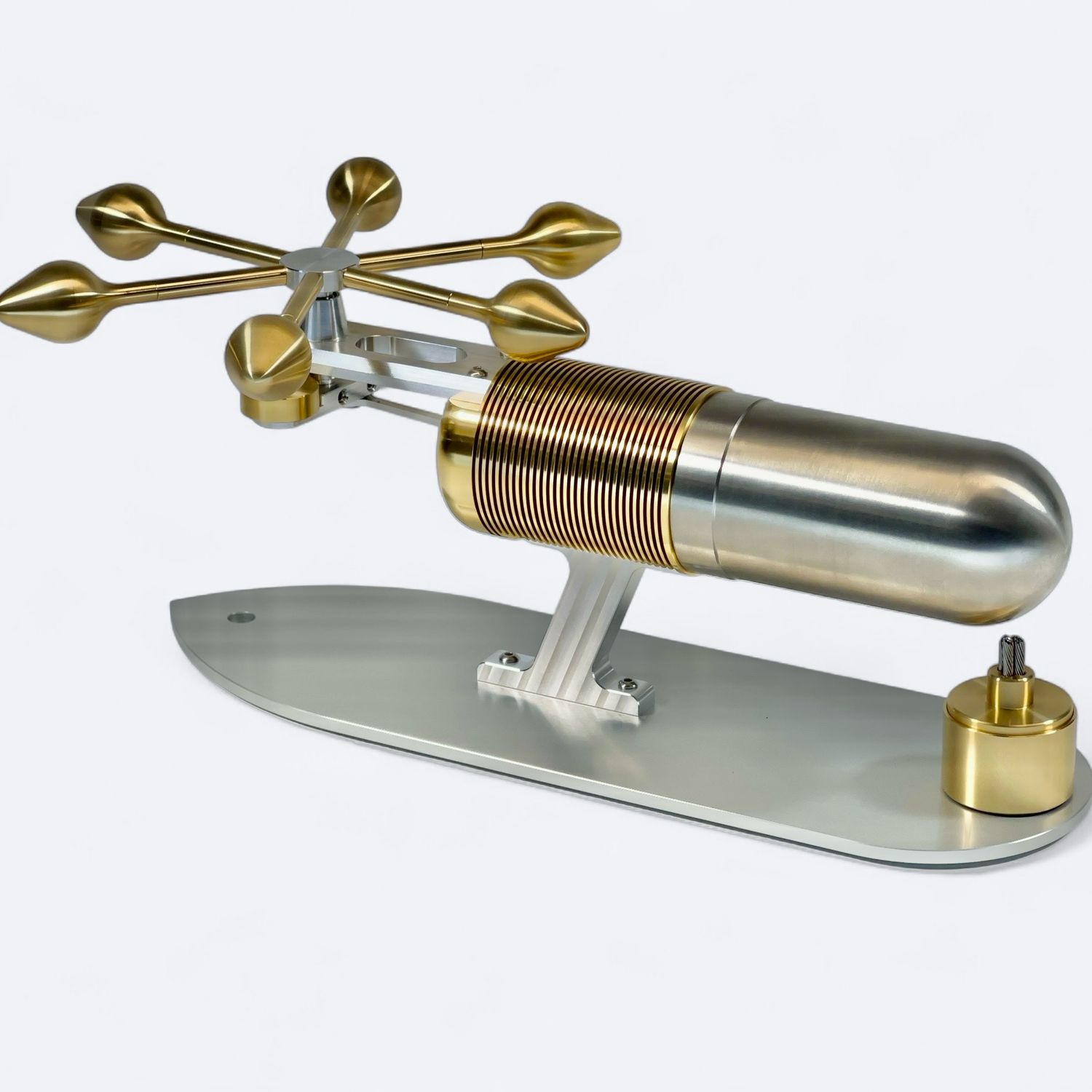Flame Pod
Flame Pod
The Kontax Flame Pod Hot Air Engine operates on the Manson-Guise principle, and features a solid brass cylinder lined with borosilicate glass, a solid graphite piston and striking brass pod-shaped spokes arranged in a hexagonal pattern. This is a BIG engine, weighing over 1.6kg and measuring 320mm in length.
How does it work?
The Manson-Guise hot air engine is an open-cycle engine that converts heat from a small flame into mechanical motion using pressure and temperature differences. Unlike the sealed Stirling engine, the Manson-Guise engine draws in and expels air during its cycle. The engine has a piston and displacer joined end to end as a single moving unit. In a conventional Manson engine there are complicated valves holes drilled into and through both the body of the piston and the walls of the cylinder. In the Manson-Guise modification, invented by our designer Chris Guise, the valves take the form of simple slots in the periphery of the piston (see photos).
A very simple explanation of the engine cycle is that a displacer shuttles air from a hot area to a cold area, with the air expanding and contracting accordingly. The expanding and contracting air drives a piston, which drives the flywheel. The internal pressure is equalised to ambient at each end of the piston and displacer stroke.
A more detailed explanation:
- The cycle begins with the suction stroke, with the piston & displacer unit moving towards the heated end of the hot cap. This movement displaces the hot air inside away from the hot end towards the cold end by the fins, causing it to cool and contract, creating a partial vacuum. Atmospheric pressure helps to push the piston & displacer unit further toward the hot end, generating motion in the flywheel.
- With the piston & displacer unit at top dead centre, the inlet valve slot in the piston briefly opens to allow the internal pressure to equalise with the atmosphere. This swift intake of air resets the pressure conditions inside the hot cap. Momentum in the flywheel helps to propel the piston & displacer unit past top dead centre and on to the next stage.
- The cycle continues with the expansion stroke, with the piston & displacer unit moving away from the hot end back towards the cold end. This motion displaces the air cooled in stage 1 back to the hot end, where it is heated again. The heated air expands, increasing the pressure inside the hot cap. This internal pressure pushes the piston & displacer unit towards the cold end, generating more motion in the flywheel.
- As the piston & displacer unit reaches bottom dead centre, the exhaust valve slot briefly opens to release the excess pressure inside the hot cap. This swift expulsion of air resets the pressure conditions inside the hot cap. Momentum in the flywheel helps to propel the piston & displacer past bottom dead centre and back to the first stage of the cycle.
Silent running
The engine is almost silent in operation, with just a tiny click coming from the conrod at each end of its stroke.
Magnetic burner
The burner features a magnetic connection to the base, which holds it firmly while allowing for small movements to fine-tune performance.
Operation
Once the burner is lit and placed on its magnetic coupling on the base, allow 2 minutes for the engine to warm up. After 2 minutes gives the flywheel a spin in either direction. The engine will increase in speed over the first 2 minutes of operation before reaching its steady operational speed, which is between 180-250rpm. The position of the burner can be adjusted and fine-tuned to give optimal performance.
Main features:
- Seed POD shaped flyweights
- Manson-Guise principle
- Runs on a methylated spirits or denatured alcohol flame
- Extremely low friction self-lubricating graphite piston
- Forever wicks included (never burns down)
- Easy to adjust burner
Materials
- Aluminium connecting rod
- Stainless steel ball-race bearings
- Micron precision borosilicate glass cylinder
- Micron precision graphite power piston
- Aluminium base and bracket
- Brass flyweights
- Brass body
- Aluminium displacer
- Stainless steel hot cap
Dimensions
- Base - 290mm x 90mm x 4mm thick (11.42in x 3.54in x 0.18in)
- Flyweights - 90mm long x 22mm thick (3.54in x 0.87in)
- Flywheel - 180mm diameter (7.08in)
- Power piston - 22mm diameter (0.87in)
- Hot cap - 47mm diameter (1.85in)
- Overall height - 125mm (4.92in)
- Overall weight - 1.6kg (3.5lb)
- Burner - 34mm diameter x 34mm high, 9.8cc (1.4in x 1.4in)
Assembled
The engine is offered as a complete self-assembly kit, typically requiring 25–30 minutes to build. Alternatively, it comes nearly assembled, with only the flyweights left to fit—a quick task that takes just a couple of minutes.
Please note: EVERY assembled Flame Pod is tested before being securely packaged.
Instructions
Click the image below for PDF assembly, operation and maintenance instructions.
 |
| Flame Pod |

